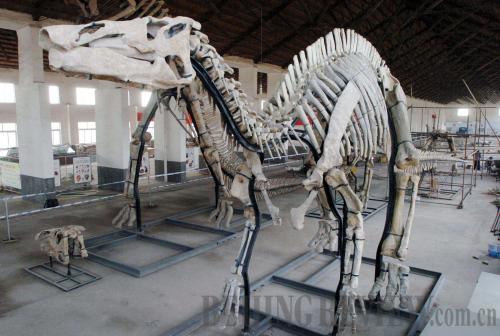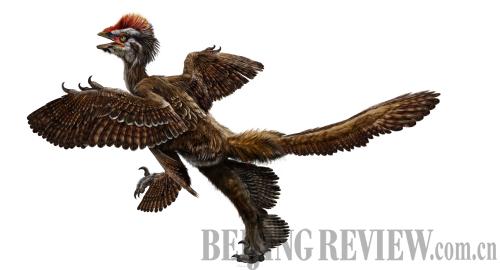|
 |
|
DINOSAUR GALLERY: The skeleton of a duck-billed dinosaur recently discovered in Zhucheng, Shandong Province, in a photo taken on October 20. Recently, scientists excavated a Zhucheng stratum containing more than 7,000 fossils belonging to at least 10 dinosaur species (WU ZENGXIANG)
 |
|
ON WINGS: A reconstruction of Anchiornis huxleyi. The dinosaur, discovered in China, is believed to be the world's earliest feathered dinosaur known so far (XINHUA) | | Whether birds came from dinosaurs has long been debated. Many people were reluctant to accept the idea that aesthetically appealing birds developed from ugly dinosaurs. To prove dinosaurs were birds' ancestors, dinosaurs with real and typical plume structures must be found, Xu said.
Fortunately, since 1996 the fossils of several dinosaurs with rudimentary plume structures have been found in China, which provide evidence supporting Huxley's hypothesis. In 1996, fossils of small Theropod dinosaurs named Sinornithosaurus were found. They have better developed feathers than those of Archaeopteryx. Their feathers, with full-blown stems and shafts, have the same shapes and structure as those of modern birds.
In 2003, scientists found the fossil of a 77-cm-long microraptor whose four limbs were covered with feathers. The shape and pattern of microraptor's feathers bear stunning resemblances to those of birds. Microraptor gave rise to the idea of a four-winged dinosaur.
This year, details of an exquisite fossil that remained buried in the west of Liaoning Province for nearly 160 million years appeared in a recently published issue of the science magazine Nature, providing convincing evidence that birds evolved from Theropod dinosaurs. This discovery has moved the history of feathered dinosaur 20 to 30 million years back. It shows dinosaurs had already donned feathers 10-20 million years before the birth of Archaeopteryx.
At the annual meeting of the Society of Vertebrate Paleontology held in 2009, Xu announced the discovery of Anchiornis huxleyi. This creature has two types of feathers: one type on its head and neck, looking similar to porcupine quills; and the other type basically resembling the structure of modern bird feathers.
Anchiornis huxleyi's fossils had been on the floor of the specimen warehouse in Xu's research institute for three to four years before Xu realized that they might belong to a new dinosaur species. When the scattered fossil pieces were put together last year, it occurred to Xu that he had never seen a dinosaur with such resemblance to a bird. It was a pity that the fossils were so poorly preserved, making further research difficult. Fortunately, Hu Dongyu, a professor in Shenyang Normal University, had a well-preserved fossil of the same species. The fossil showed the entire dinosaur was covered with feathers. Even the feathers on the toes were clearly seen.
The feathers covering the legs of Anchiornis huxleyi are clear evidence supporting the existence of a "four-wing" period, and show the complexity of the evolution process, said James Clark, a professor at the George Washington University. Clark and Xu were in a team of Chinese and U.S. paleobiologists who recently found a beaked, plant-eating dinosaur named Limusaurus inextricabilis. This dinosaur species has supplied important evidence on how birds' toes evolved from dinosaurs' hands.
On October 14, 2009, a group of Chinese and British researchers found the fossils of a new type of Pterosaur in northeast China, "filling in the gaps in the evolutionary record of the extinct flying reptiles," according to a Canadian Broadcasting Corp. news report. Scientists named the dinosaur Darwinopterus, to mark the 200th anniversary of Darwin's birth and the 150th anniversary of the publication of On the Origin of Species.
Darwinopterus also suggests evolution may occur in modules. For instance, groups of features in the head, neck and tail may evolve together, said David Unwin of the University of Leicester.
The evolutionary relations between dinosaurs and birds have not only been proven by analysis of fossils. John M. Asara, a professor at Harvard Medical School recently matched proteins of a Tyrannosaurus that lived on Earth 68 million years ago with those of birds. This is the first time that the kinship between dinosaurs and birds has been proven by molecular level studies. |
